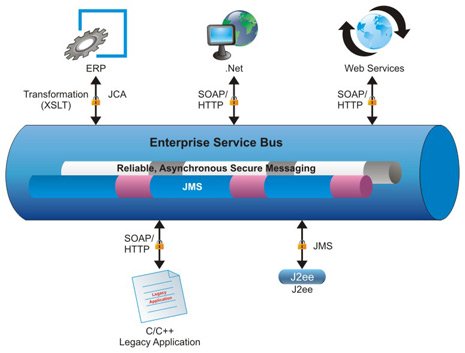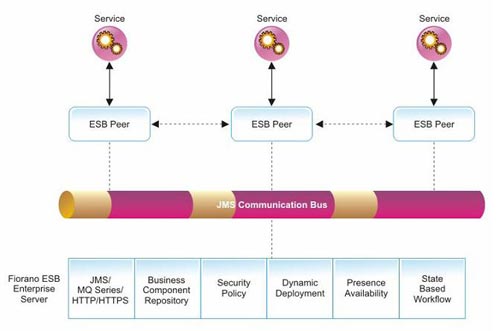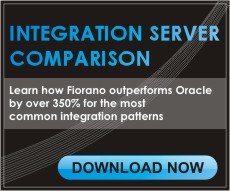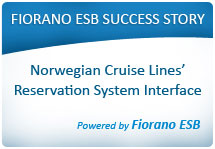|
Todays enterprise networks typically deploy hundreds of applications from different vendors. Theres little standardization of communication protocols between individual enterprise systems, and exchanging data between applications from different vendors is surprisingly hard. The lack of a standard platform for distributed enterprise applications increases the cost and complexity of developing and deploying business solutions. Emerging standards for enterprise communication, connectivity, transformation, portability and security have tried to simplify the enterprise integration and middleware problem.
The Enterprise Service Bus (ESB) is a new breed of
enterprise middleware designed to alleviate these and
other problems. An Enterprise Service Bus provides an
opportunity to apply truly open industry standards in a
heterogeneous, best-of-breed environment.
Standards-based technology coordination expands choices
and is less costly.

Fiorano Enterprise Service Bus
Enabling Standards-Based Integration
An ESB is a foundation for an enterprise-wide SOA,
allowing enterprises to integrate applications and
processes as standards-based, event-driven services over
a highly distributed, centrally managed infrastructure.
With no single point of failure, ESBs are inherently
reliable and linearly scalable and have no performance
bottlenecks. ESB Services (including
application/business logic as well as fundamental
transformation, routing, connectivity and distribution
services) may be deployed and managed from any physical
location across the enterprise network. Built entirely
on industry standards including XML and Web Services,
ESBs enable the next wave of comprehensive and
affordable integration solutions, unifying applications
and infrastructure within an enterprise and delivering
the value IT departments are looking for via reuse,
flexibility and faster time to market.
An Enterprise Service Bus is an enterprise platform that implements standardized interfaces for communication, connectivity, transformation, portability, and security. Specific standards include:
Communication:
Standards-based communication infrastructure, (for
example, JMS).
Services need to communicate reliably with each
other over the network. A reliable, scalable,
robust, and location-independent communications
system dramatically reduces the development time for
distributed systems while increasing reliability.
Connectivity
Standards-based connectivity including Web services,
Java 2 Enterprise Edition (J2EE), and .NET adapters.
(Suns J2EE and Microsofts .NET are the two
dominant distributed computing architecture
frameworks. J2EE provides portability of a single
language [Java] over multiple operating systems and
hardware platforms. .NET supports a wide range of
languages but is primarily tied to the Microsoft
Windows operating system and Intel hardware.).
To extract data from a service, one first needs
to be able to easily connect to that service. Absent
any standards, this has been difficult.
Transformation
Standards-based transformation engines (for example,
XSLT and Xquery).
Data produced by a given
service is typically not easily understood by
another service; to make the data digestible by
another service, it first needs to be suitably
transformed.
Portability
Modern Enterprise Service Bus implementations
typically support development in multiple
programming languages. This, coupled with the
inherent portability of the ESB infrastructure,
makes the Enterprise Service Bus a true
multi-language, multi-platform enterprise backbone.
Most enterprises have a variety of computer
systems, ranging from thin-clients and Windows
desktop PCs to higher-end UNIX servers and mainframe
systems. Portability and ease of communication
between different operating environments remain
concerns for enterprise solutions.
Security
Standards-based security (for example, LDAP and SSL
).
Finally, all connectivity to and
communication between enterprise services need to be
secure at levels satisfactory to the enterprise.
Since distributed applications span different
departments and locations within and outside the
firewall, security is highly important.
Fiorano Enterprise Service Bus System Architecture
The Fiorano ESB implements a brokered, peer-to-peer
(often referred to as super peer) system
architecture, which combines the management benefits
of typical centralized hub-and-spoke systems with
the performance benefits of fully distributed
peer-to-peer systems, while avoiding the particular
disadvantages of both of these individual
approaches. The following figure illustrates the
Fiorano ESB brokered peer-to-peer architecture.

Fiorano Enterprise Service Bus System Architecture Particular benefits of the Fiorano ESB system architecture include:
- Enterprise Class Backbone:
Underlying the ESB architecture is an
enterprise-class, standards-based messaging backbone
which provides secure and reliable communications
between any number of applications and distributed
processes across the enterprise. Using Fioranos
unique distributed peer-to-peer JMS implementation,
the backbone allows distributed processes and
composite applications to scale to meet the
requirements of the most demanding global enterprise
networks.
- Efficiency: ESB peers at the end-points of the
network allow the components of a distributed
application to exchange data concurrently, enabling
all of the parallelism in a distributed business
process to be exploited. For instance, an order
management system in a manufacturing plant can check
its inventory status even as the sales-force
management system is updating the order database.
Data transformations and other computations required
by distributed business processes are performed
concurrently at the end-points of the network.
- Unbounded Scalability: With
dispersed computation and parallel data flow between
nodes, ESB peers scale naturally and seamlessly with
the addition of new peer nodes and Enterprise
Services across the network.
- Fault Tolerance: Multiple peer
servers at the end-points of the Fiorano ESB network
ensure that there is no single point of failure. If
one of the peers fails, Services connected to that
peer fail-over to another peer in the system,
allowing distributed processes to remain unaffected;
in the case of a catastrophic failure at a peer
node, the rest of the system continues operation,
localizing losses to the failed node only.
- Ease of Administration: In a
Fiorano ESB network, operations such as
event-handling, security authentication and
administration are performed by centralized servers.
ESB peers at the end-points of the network are
easily administered via tools connected to the
centralized ESB Enterprise Server.
Fioranos brokered peer-to-peer architectural
approach thus combines the benefits of both peer-to-peer
systems and hub-and-spoke systems in a single cohesive
architecture for a scalable enterprise backbone.
Enterprise Service Bus Benefits
Enterprise Service Bus leverage recent integration
technology enhancements into a standards- based,
affordable package. Enterprise Service Bus offer
several advantages over existing, proprietary
integration solutions:
Extended,
Standards-based Connectivity
Enterprise
Service Bus incorporate a standards based messaging
backbone, letting systems within and across the
entire value chain easily exchange information via
asynchronous or synchronous messaging. An Enterprise
Service Bus provides enhanced systems connectivity
using Web services, J2EE, .NET, and other standards.
Flexible, Service-based Application
Composition
Based on SOA, the Enterprise
Service Bus application model allows complex
distributed systems, including integration solutions
spanning multiple applications, systems, and
firewalls, to be composed from pre-built, pre-tested
services. This provides easy extensibility.
Reduced TCO via Enhanced Reuse
The SOA approach to application construction
directly promotes reuse, easing maintenance and
further reducing system TCO.
Reduced
Time-to-market and Increased Productivity
An Enterprise Service Bus provides these benefits
through the reuse of components and services, and
the ease of application composition offered by an
SOA, standards-based communication, transformation,
and connectivity. All these benefits derive from the
strong support for standards in each component of
the Enterprise Service Bus architecture:
communications, connectivity, transformation,
portability, and security.
An Enterprise
Service Bus delivers a powerful, affordable,
standards-based backbone throughout the enterprise
and partner organizations. It smoothes the
operational path of the processes running a business
and reduces the time, effort, and cost of
integrating the different components supports these
process steps. A powerful benefit of this type of
approach is that it allows in-house development
teams to build new applications that are already
integration-enabled and can easily be incorporated
into the Enterprise Service Bus as required.
Associated benefits include savings on investments
of expensive
|






 全球业务支持
全球业务支持
